The education of children living in children's homes
Published 17 February 2021
Applies to England
Background
This study covers:
- the full range of school-aged children living in children’s homes, including those attending primary schools, secondary schools and further education and skills (FES) providers
- a wide range of educational provision types, including state-funded, independent, mainstream and special education provisions
- the period between 1 April 2018 and 31 March 2019
Main findings
The majority of children living in children’s homes attended educational provision that is eligible for Ofsted inspection.
In our sample of 2,600 children living in children’s homes:
- 2,165 children (83%) attended educational provision eligible for Ofsted inspection
- 9% attended unregulated provisions
- 6% were not in education, employment or training
- 2% attended educational provision inspected by the Independent Schools Inspectorate (ISI)
Of the children who attended educational provision eligible for Ofsted inspection, more than half were in special education.
Of the 2,165 children in our sample who attended an educational provision eligible for Ofsted inspection, 57% were in special schools (35% independent special schools and 22% in state-funded special schools). The remaining 43% of children attended mainstream education (6% independent mainstream education and 37% state-funded mainstream education).
Children living in children’s homes were 20 times more likely to be in special education than all children nationally.
The children in our sample were 20 times more likely to be in special education than all children nationally. This reflects the complex needs of many children entering children’s homes.
Children living in children’s homes were less likely to attend good or outstanding education provisions.
In our sample, 82% of children attended good or outstanding education provisions. This is 2 percentage points lower than all children nationally (84%). This gap was wider for children who attended state-funded mainstream schools (76% of our sample, 84% nationally) and state-funded special schools (88% of our sample, 93% nationally).
Nationally, for those attending state-funded educational provision, around three quarters of children living in children’s homes had an education, health and care (EHC) plan or were receiving special educational needs (SEN) support.
When looking beyond our sample to all children living in children’s homes and attending state-funded education nationally (approximately 2,500 children), 47% had EHC plans. A further 27% were receiving SEN support. For all children nationally, the proportions were 3% and 12% respectively.
Children living in children’s homes were 18 times more likely to be attending a pupil referral unit (PRU) than all pupils attending state-funded provision nationally.
Although less than 1% of all state-funded, mainstream-educated children attended PRUs nationally, the figure was 18% in our sample. Children in children’s homes make up less than 0.1% of the state-funded school population, but they represent more than 3% of the PRU population.
Children living in children’s homes were less likely to be attending good or outstanding FES providers.
In our sample, only 66% of children attending FES providers attended a provision with a good or outstanding judgement. This is 17 percentage points lower than for all children nationally (83%).
Introduction
As at 31 March 2019, around 5,260 children were living in children’s homes in England (excluding children who were in short breaks children’s homes and those in residential special schools registered as children’s homes). This represented around 7% of all children then in care.[footnote 1]
Research on the education of children in children’s homes in England has most often been explored alongside the education of all children in care. For several decades, it has been recognised that there are substantial gaps in educational attainment between children in care and their peers. Much of the research has consequently focused on the analysis of, the accounting for, and suggestions of how to close, these gaps.[footnote 2]
More recently, research has concluded that children in children’s homes have the largest gaps in levels of attainment from their peers. These are much larger gaps than for other children in care, for example those in kinship or foster care.[footnote 3]
Only one study examined the type of educational settings that children in children’s homes attended.[footnote 4] This study reported on the educational provision for a small sample of children (56). It found that 23 children were in mainstream education (including further education); 11 attended special (day) schools; 5 attended pupil referral units; 7 were receiving group tuition; 4 were receiving other provision within their children’s home; and 5 were not currently receiving provision (see Table 5).
There is also very limited research on the quality of educational provision that children living in children’s homes receive. We are not aware of any studies that have looked at the Ofsted or ISI judgements of these children’s education settings.
In this study, we start to address this shortfall by asking:
- where do children living in children’s homes receive their education?
- what is the quality of educational provision, expressed by Ofsted inspection grade, received by children living in children’s homes?
In both cases, we compare the sample of children living in children’s homes with the picture of all children nationally.
In Her Majesty’s Chief Inspector’s Annual Report 2019/20, we started to look at this subject and briefly discussed the education of children in all types of children’s homes. Our analysis included residential special schools registered as children’s homes, secure children’s homes and homes exclusively offering short breaks.
This study, though, excludes secure children’s homes and residential special schools. Education in these settings is always provided on site and is considered as part of the inspection of the setting. It also excludes children’s homes only providing short breaks or respite care, since children in these settings do not spend the majority of their lives there. The study also explores the location and quality of the education received by children living in short- and long-term care.
You can find details of the methodology and limitations of this paper in the Appendix.
Where children living in children’s homes receive their education: findings
Children go to live in children’s homes for many different, and often multiple, reasons. Some will have experienced, for example, issues such as: family breakdown; sexual exploitation; going missing from previous care placements, mental ill health; fostering placement breakdown; criminal exploitation; children’s home placement breakdown; and, more rarely, adoption breakdown.
Often, they are placed in those homes that are equipped to help them with their complex emotional and behavioural needs. These homes can provide: a therapeutic environment that can help with their issues; an environment that meets their educational needs, including providing educational continuity with their previous placement; an environment to support them following the unplanned ending of one or more foster placements; an opportunity to live within the placing authority; family continuity; and an opportunity to live some distance from their original home. On occasion, they may also be placed in a home because it is the only available placement that the local authority (LA) can commission for them.
Children typically enter children’s homes in older childhood. Of the approximately 5,260 children living in children’s homes as at 31 March 2019, the majority (86%) were aged 12 or older.
Figure 1: Age of children living in children’s homes as at 31 March 2019
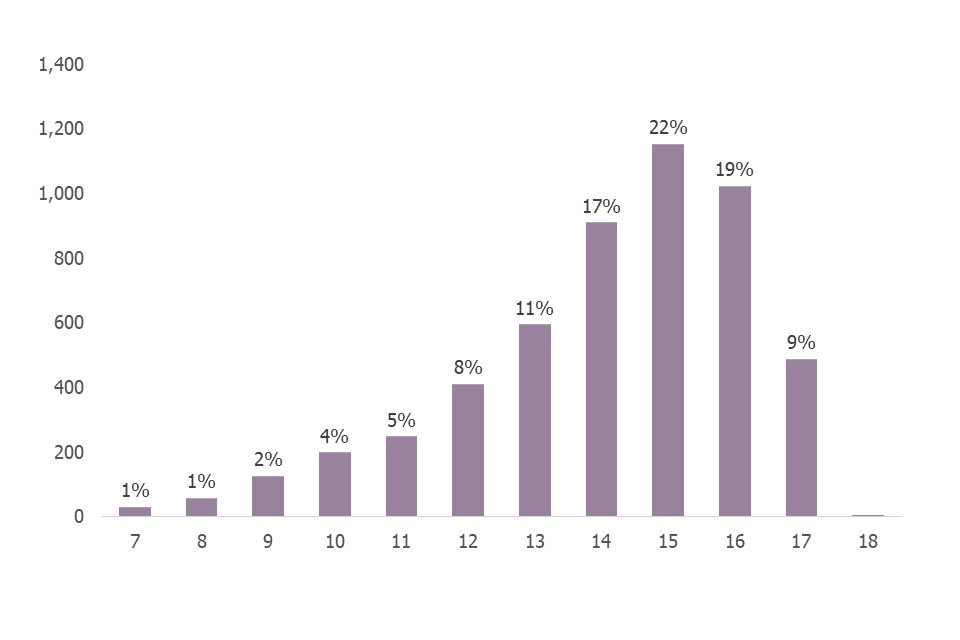
The data for Figure 1 was sourced from the Department for Education (DfE) children looked after data return (also known as the SSDA 903), 2018 to 2019.
Download a zip file with the data used in figures.
Our sample consisted of 2,600 children living in 815 children’s homes. This represents around 44% of all homes and just under half of all children living in children’s homes at any one time in the 2018 to 2019 inspection year. This sample does not necessarily represent all children living in children’s homes; you can find details of our methodology and the limitations of our sample in the Appendix.
Figure 2 shows that, in our sample, the majority of children (83%) attended educational provision inspected by Ofsted.
Figure 2: Educational provision of children living in children’s homes in England
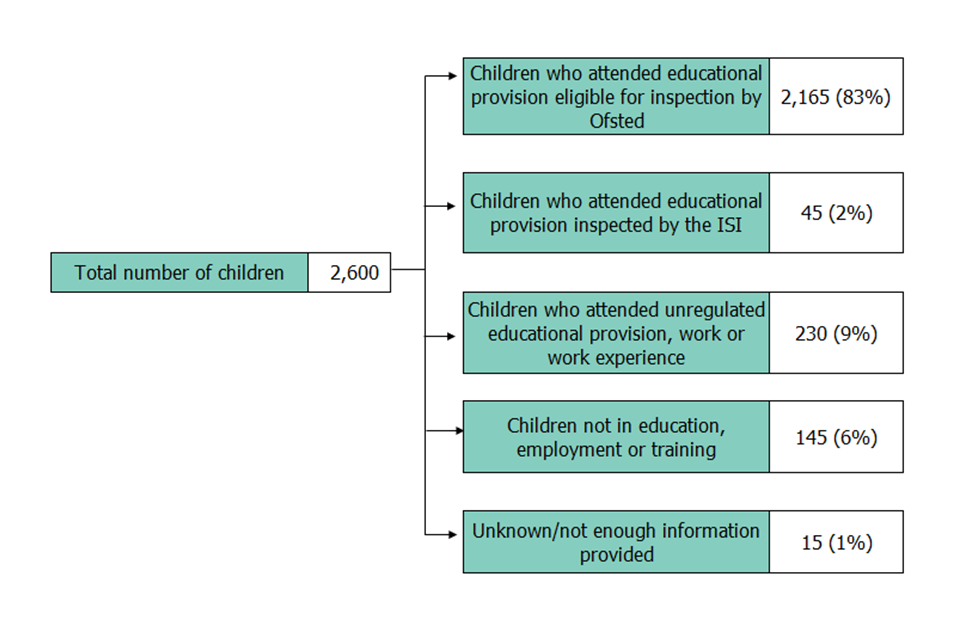
Numbers may not add up due to rounding. Numbers of children rounded to nearest 5.
Of the 2,165 children who attended educational provision eligible for inspection by Ofsted, 100 children attend a provision that is yet to have its first inspection.
Download a zip file with the data used in figures.
Around 9% of children in our sample (230) attended unregulated educational provision. A breakdown of the provision received by these 230 children is shown in Table 1 below. We cannot say much more about the education received by these 230 children since their educational providers are unregulated. Unregulated providers are not required to register with any educational body or undergo regulatory inspection.
Table 1: Breakdown of the types of provision for children receiving unregulated educational provision
| Education/employment provision | Number of children | Proportion of total sample |
|---|---|---|
| Alternative provision (including online schools) | 120 | 5% |
| One-to-one or in-house tuition | 95 | 4% |
| Employment/work experience | 15 | 1% |
| Total | 230 | 9% |
Numbers may not add up due to rounding. Numbers of children rounded to the nearest 5.
Around 2% (45) of the children in our sample attended ISI-inspected providers. The vast majority of these schools were judged to have met regulatory expectations. These children are not included in the remainder of this study because we have no national comparator for them: there is no national database of children attending ISI-inspected schools.
The remainder of this study considers the education received by children attending schools eligible for inspection by Ofsted. This includes 2,165 children who attend a provision that has been inspected as at 31 March 2019, and 100 children who attend a provision that is yet to have its first inspection.
Figure 3 shows the breakdown of the children in the sample by whether they were in a mainstream or special school, and whether their provider was state-funded or independently funded. It is worth noting that while many children living in children’s homes attend independent providers, this was nearly always paid for by the LA responsible for the child.
Figure 3: Breakdown of children living in children’s homes attending special/mainstream and independent/state-funded providers eligible for inspection by Ofsted
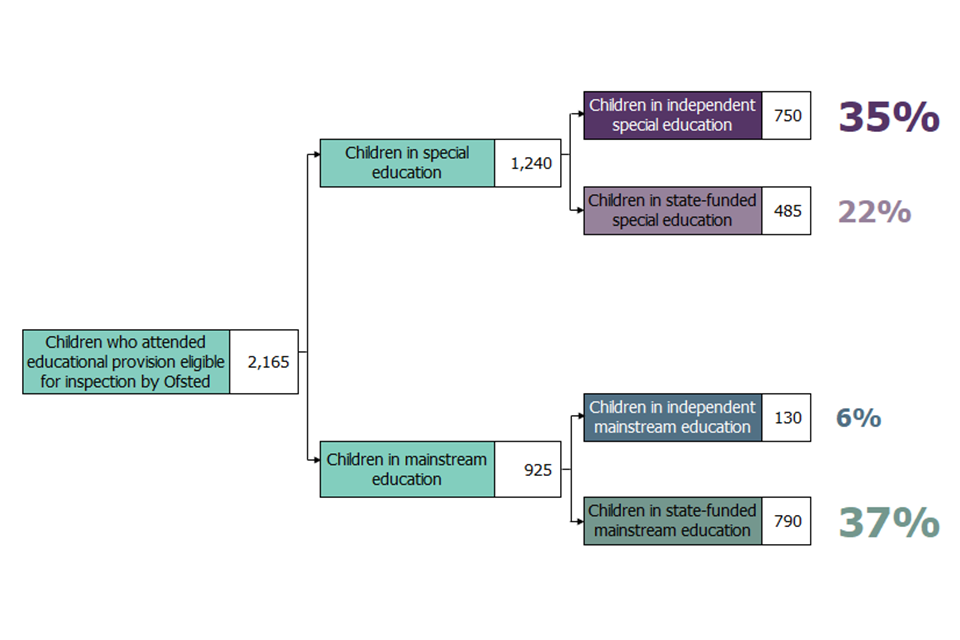
Numbers may not add up due to rounding. Numbers of children rounded to the nearest 5.
Of the 2,165 children who attended educational provision eligible for inspection by Ofsted, 100 attend a provision that is yet to have its first inspection.
Download a zip file with the data used in figures.
Special education
In our sample, more than half of the children who attended educational provision eligible for Ofsted inspection (1,240 children, 57%) were in special education.
Children living in children’s homes were 20 times more likely to attend special educational provision than all children nationally. This reflects the complex needs of many children entering children’s homes.
When looking beyond our sample to all children living in children’s homes and attending state-funded education nationally (approximately 2,500 children), 47% had EHC plans. A further 27% were receiving SEN support. Among all children nationally, the proportions were 3% and 12% respectively.
Of the children in our sample who attended a special education provider, 61% (750) attended an independent special school (Figure 4). Among all children nationally, just 7% of those attending a special education provider attended an independent special provider.
Figure 4: Children attending special education providers, split by whether they were independent/state-funded 2018–2019

Numbers may not add up due to rounding. Numbers of children rounded to the nearest 5.
Download a zip file with the data used in figures.
This disparity is partly accounted for by the large number of children who were in children’s homes with linked educational providers: these are used primarily, or exclusively, to educate children living in their children’s homes. In our sample, 885 children attended Ofsted-inspected independent education settings: 750 attended independent special schools and 135 attended independent mainstream schools. Of these children, 365 were attending education providers owned by the same parent organisation as their children’s home. This accounts for around 1 in 7 (14%) of the total sample.
Around three quarters of children’s homes are in the private sector, and many have linked educational providers. As a result, around half the children in private children’s homes attended independent education, compared with around one tenth of those in LA homes.
Mainstream education
Of the 2,600 children in our sample, around a third (925 children, 36%) attended mainstream (non-special) education eligible for Ofsted inspection.
Those in our sample who attended mainstream education were more than twice as likely to attend an Ofsted-inspected independent mainstream provider than all children nationally (14% of children in children’s homes, 5% nationally). Despite this, the vast majority of children living in children’s homes in mainstream education attended state-funded providers (790 children, 86%).
The breakdown of what provision type (primary, secondary, PRU and FES) children living in children’s homes attended was very different from the provision type breakdown of all children nationally (Figure 5). The smaller proportion of children attending primary school in the children’s home sample is not unexpected – most children living in children’s homes are teenagers.
Figure 5: Children in mainstream state-funded provision eligible for Ofsted inspection, by provision type
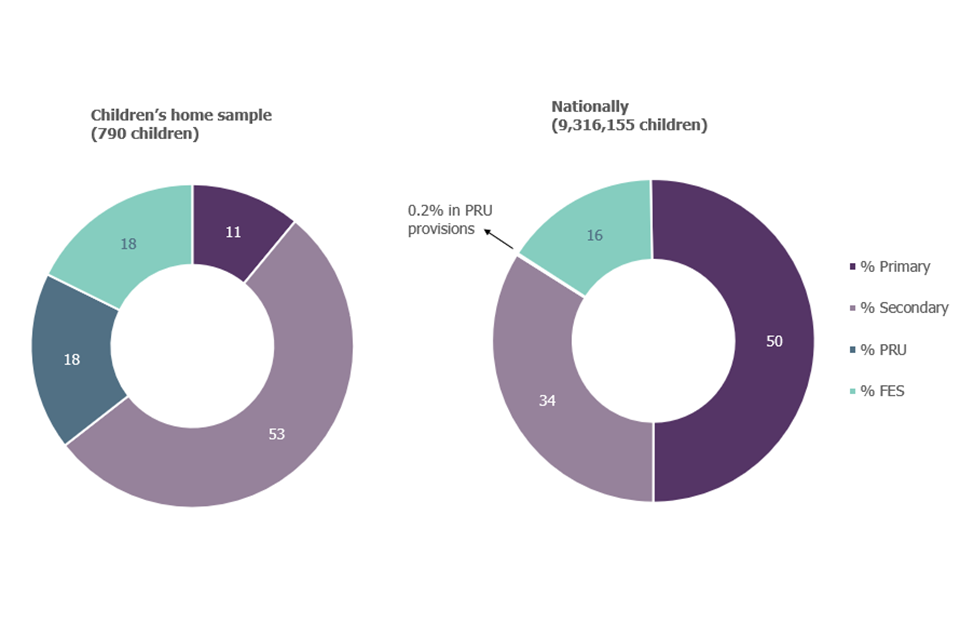
Numbers may not add up due to rounding. Numbers of children rounded to the nearest 5.
Download a zip file with the data used in figures.
Children in primary schools
Nationally, around half of all children in state-funded mainstream provision attended primary schools in 2018 to 2019. In contrast, only 6% of children in children’s homes attended state-funded mainstream primary schools. Of these children, two thirds were aged at least 9 at the start of the year (Figure 6). This is consistent with the general trend for children’s homes to be predominantly for older children.
Figure 6: Age profile of children who live in children’s homes and attend state-funded primary schools nationally
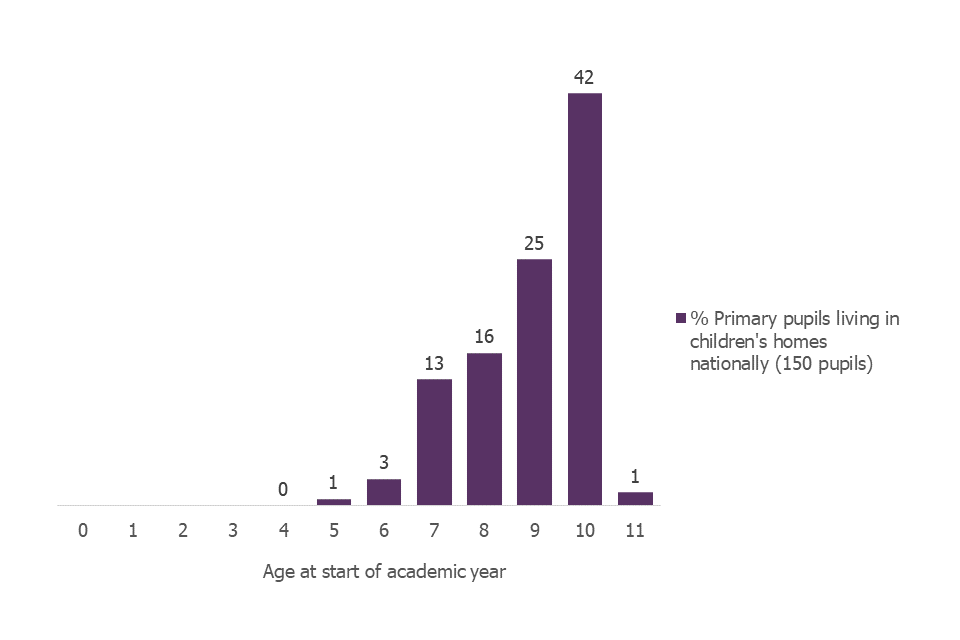
Download a zip file with the data used in figures.
Of the 150 children in our sample who attended state-funded primary schools, more than half (53%) had a primary SEN type relating to their social, emotional and mental health (SEMH). A quarter had no identified SEN.
Children in PRUs
Nationally, less than 1% of all state-funded mainstream-educated children attended PRUs. In our children’s home sample, the figure was 18%. Although children in children’s homes made up less than 0.1% of the national state-funded school population, they represented more than 3% of the PRU population.
There is a strong link between children with SEMH and PRU attendance. This is true both nationally and for children in children’s homes. Nationally, 65% of children in state-funded PRUs have a primary SEN of SEMH. Among the children’s home population, it was 75%. Children in our sample were, overall, less likely to have no identified SEN than their peers. This likely reflects the traumatic life experiences of many children living in children’s homes. The proportions for other primary SEN types was similar between the 2 groups.
Figure 7: Proportion of children attending PRUs by SEN status: for children in children’s homes and all children nationally
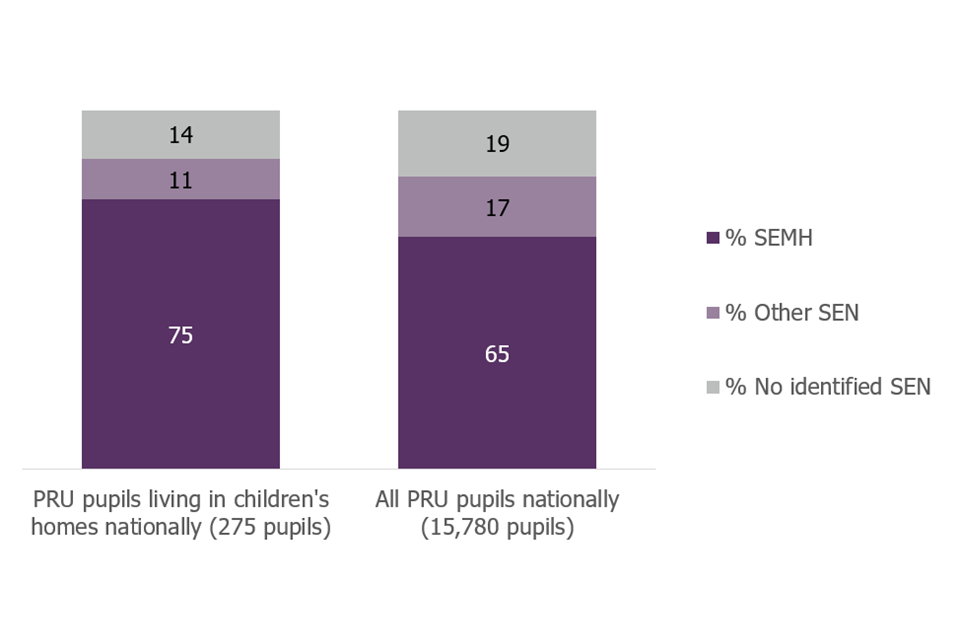
Download a zip file with the data used in figures.
Academy and LA-funded provision
Nationally, around 59% of all children attending state-funded educational provision attended LA-maintained providers. Children living in children’s homes were slightly less likely to attend an LA-maintained secondary school than all children nationally in 2018 to 2019 (32% nationally, 28% among children in children’s homes). In all other educational phases, there was little difference between children in children’s homes and all children.
Ownership groups
From the sample of 2,600 children, we looked at children’s home ownership groups with more than 10 children attending their schools. The results are summarised below in Table 2. Around 17% of the children (445) attended schools run by 13 ownership groups. The top 4 ownership groups also featured in the top 10 largest children’s homes providers as at 31 March 2019.
Table 2: Children’s homes owners with more than 10 children from our sample attending schools in their ownership group 2018–2019
| Name of ownership group | Number of children in the children’s homes sample attending schools in the ownership group |
|---|---|
| Outcomes First Group Limited | 105 |
| Priory Education Services Limited | 60 |
| Keys Educational Services Limited | 60 |
| CareTech Holdings Plc | 50 |
| Witherslack Group Ltd | 45 |
| Care4Children Residential Services Limited | 25 |
| Horizon Care and Education Group Limited | 20 |
| Hexagon Care Services Limited | 15 |
| Hopedale Children and Family Services Limited | 15 |
| Bright Futures Care Limited T/A Cornerstones | 15 |
| Ethelbert Children’s Services Limited | 15 |
| Institute of Integrated Systemic Therapy | 10 |
| Bryn Melyn Care Limited | 10 |
Numbers may not add up due to rounding. Numbers of children rounded to the nearest 5.
The quality of educational provision received by children living in children’s homes: findings
There are many ways to judge the quality of education received by children in children’s homes and more broadly. Some measures of quality, such as ‘sense of well-being’ and ‘readiness for life’, are notoriously hard to track.
In this section, we consider quality in terms of the Ofsted judgements awarded at the most recent education inspection for each provider, as at 31 March 2019. This time period covers inspections carried out under the common inspection framework, which we used between 2015 and September 2019 (it has now been replaced by the education inspection framework). The previous framework sought to:
use all the available evidence to evaluate what it is like to be a child, learner or other user in the provision. In making the judgements about a provider’s overall effectiveness, inspectors will consider whether the standard of education, training or care is good or outstanding. If it is not at least good, inspectors will consider whether it requires improvement or is inadequate.
Under that framework, inspectors used the 4-point scale to assess 4 areas of an educational provider, namely, the ‘effectiveness of leadership and management’, ‘quality of teaching, learning and assessment’, ‘personal development, behaviour and welfare’ and ‘outcomes for children and learners’.
In total, 2,065 (79%) of the 2,600 children living in children’s homes attended an educational provider that had been inspected by Ofsted by 31 March 2019. An additional 100 children attended educational provision that was eligible for Ofsted inspection but had yet to receive one by 31 March 2019. These children are excluded from the following analyses.
Children living in children’s homes were slightly less likely than all children nationally to be attending a good or outstanding educational provider in 2018 to 2019 (84% nationally, 82% among children in children’s homes, as shown below in Figure 8.
Figure 8: Proportion of children in Ofsted-inspected educational provision by overall effectiveness judgement as at 31 March 2019
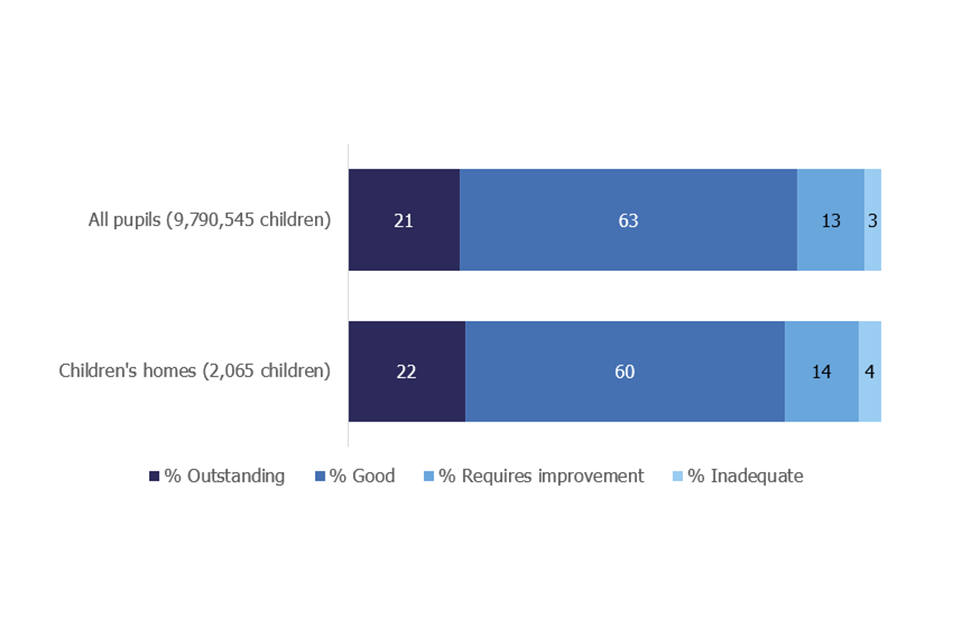
Download a zip file with the data used in figures.
Due to the large number of children in children’s homes attending special and independent education providers, we have broken the inspection judgements down by phase and funding status in the sections below.
Special education: funding status
Many children enter children’s homes because of complex disabilities or learning needs that require specialist provision. More than half of the children in our sample who attended provision inspected by Ofsted by 31 March 2019 (1,215 children, 59%) were in special education, in a mixture of independent and state-funded settings.
Figure 9: Breakdown by funding source of children living in children’s homes attending Ofsted-inspected special education
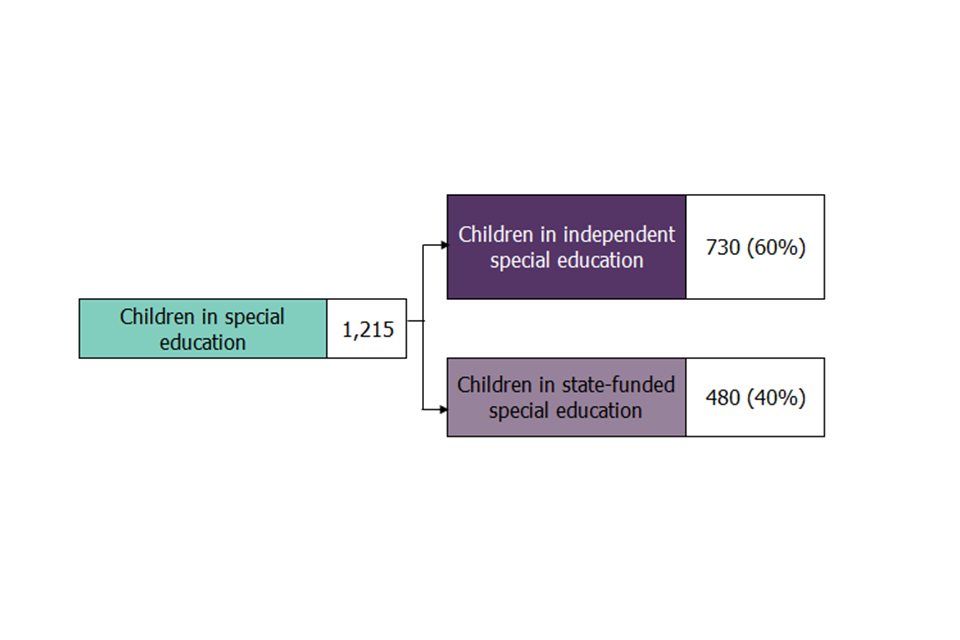
Numbers may not add up due to rounding. Numbers of children rounded to the nearest 5.
Download a zip file with the data used in figures.
Independent special schools: Ofsted inspection judgements
Of the 730 children in independent special education that had been inspected by Ofsted as at 31 March 2019, 615 (84%) were in good or outstanding independent special schools. This was 3 percentage points lower than all children nationally (87%).
Figure 10: Proportion of children in Ofsted-inspected independent special education, by overall effectiveness judgement
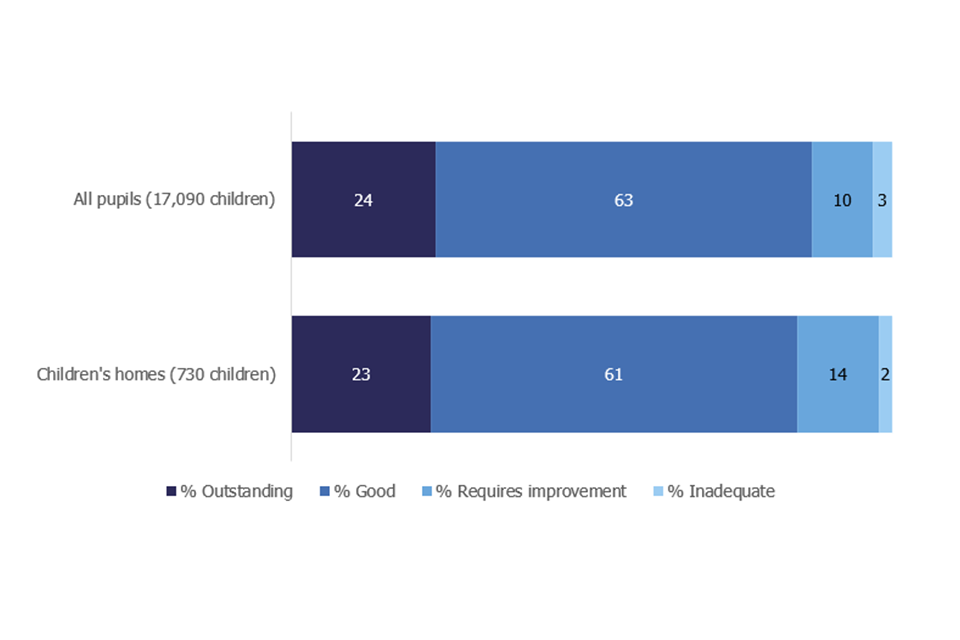
Download a zip file with the data used in figures.
The 5 largest providers of independent special schools attended by children in the sample were: Outcomes First Group Limited, Priory Education Services Limited, CareTech Holdings Plc, Keys Educational Services Limited and Witherslack Group Ltd. These 5 providers own the educational provisions attended by 320 of the children in our sample; 44% of those who attended independent special education. All 5 also featured in the 10 largest children’s homes providers as at 31 March 2019.
The proportions of children attending good or outstanding educational providers were higher in the Outcomes First Group Limited, Keys Educational Services Limited and Witherslack Group Ltd schools than in the sample of 2,600 children overall.
Ofsted inspection judgements for linked/on-site and off-site provision types
In a previous section, we saw that around 1 in 7 children in the sample (365 children) attended educational provision run by the same provider as their children’s home. The probability that those children lived in a children’s home judged good or outstanding as at 31 March 2019 was 90%, while the probability that the linked educational provision was good or outstanding was 88%.
These figures were higher than among those children who attended educational provision that was not run or owned by their children’s home providers. Of these children, 82% were living in a children’s home that had been judged good or outstanding and 81% attended an education provider judged good or outstanding.
Children in homes with linked education providers were more likely to be in a good or outstanding educational provider than all children nationally: 88% of children in children’s homes with a linked provider, compared with 85% nationally.[footnote 5] The opposite was true for children attending educational providers that were not linked to their children’s home: 81% in homes without linked educational provision, compared with 85% nationally.
Figure 11 shows that the majority of children in both groups lived in good or outstanding children’s homes and received good or outstanding educational provision. The proportion was 12 percentage points higher among those children in homes with linked/on-site education. The proportion of children living in less than good children’s homes and attending less than good educational provision was higher among those attending off-site education, at 4%, than those who attended linked/on-site provision (1%).
Figure 11: Children in sample by overall effectiveness judgement of most recent children’s home inspection and most recent educational provision inspection as at 31 March 2019
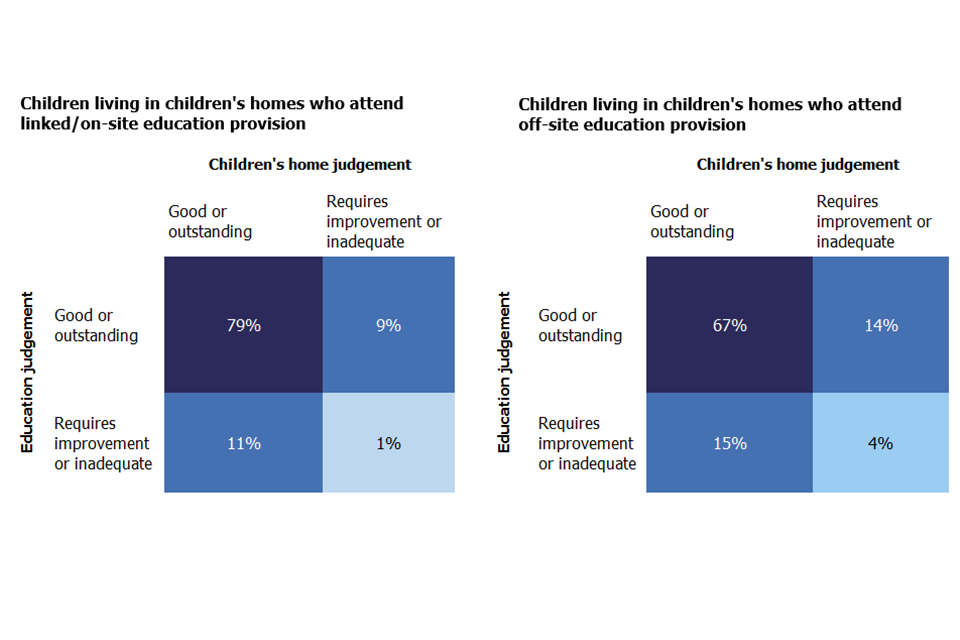
Download a zip file with the data used in figures.
State-funded special schools
The sample of 2,600 children in children’s homes included 480 children who attended state-funded Ofsted-inspected special schools (Figure 12). The proportion of these children who attended good or outstanding educational providers (88%) was 5 percentage points lower than the proportion of all children in state-funded special education provision nationally (93%), although children in children’s homes were more likely to attend an outstanding provider than nationally.
Figure 12: Proportion of children in Ofsted-inspected state-funded special education by overall effectiveness judgement as at 31 March 2019

Numbers may not add up due to rounding. Numbers of children rounded to the nearest 5.
Download a zip file with the data used in figures.
Mainstream education: Ofsted inspection outcomes
Of the 2,600 children in our sample, 850 (33%) attended Ofsted-inspected mainstream education. Of these children, 745 were in state-funded mainstream education and 105 were in independent mainstream education.
Independent mainstream education
Figure 13 shows that children living in children’s homes were slightly more likely to be attending good or outstanding mainstream independent provision than all children nationally (80% among children in children’s homes, 79% nationally). They were also far less likely to be attending inadequate provision.
Figure 13: Proportion of children attending Ofsted-inspected mainstream independent funded provision (including independent further education providers) by overall effectiveness judgement as at 31 March 2019
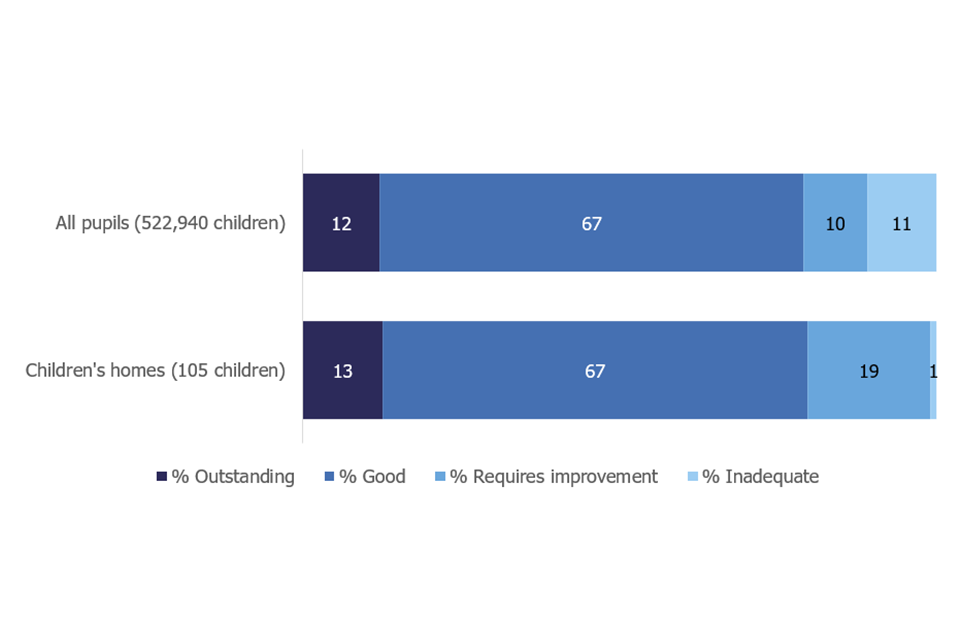
Download a zip file with the data used in figures.
State-funded mainstream education
In total, 745 children (29%) in our sample of 2,600 attended a state-funded mainstream education provider that had an Ofsted inspection judgement as at 31 March 2019.
Overall, 76% of these children attended educational provision that was good or outstanding. As at 31 March 2019, the figure nationally was 84% (Figure 14). Children in this group were more likely to be attending schools judged requires improvement (6 percentage points higher than nationally) and more likely to be attending an inadequate provider (2 percentage points higher than nationally).
Figure 14: Proportion of children attending Ofsted-inspected mainstream state-funded provision by overall effectiveness judgement as at 31 March 2019

Download a zip file with the data used in figures.
State-funded mainstream education by Ofsted phase
One hundred children in the sample of 2,600 attended a FES provider. The proportion of children in children’s homes in good or outstanding FES providers (66%) was 17 percentage points lower than the proportion of all children in FES provision nationally (83%).
Children in children’s homes were also less likely to be in a good or outstanding secondary school (77%) than all children nationally (80%), or a good or outstanding PRU (72%) than nationally (77%).
The situation was more positive among the 86 primary-aged children. The proportion of children in children’s homes in good or outstanding primary schools (90%) was slightly higher than the proportion of all children nationally (87%).
Figure 15: Proportion of children attending Ofsted-inspected mainstream state-funded provision by Ofsted phase and overall effectiveness judgement as at 31 March 2019
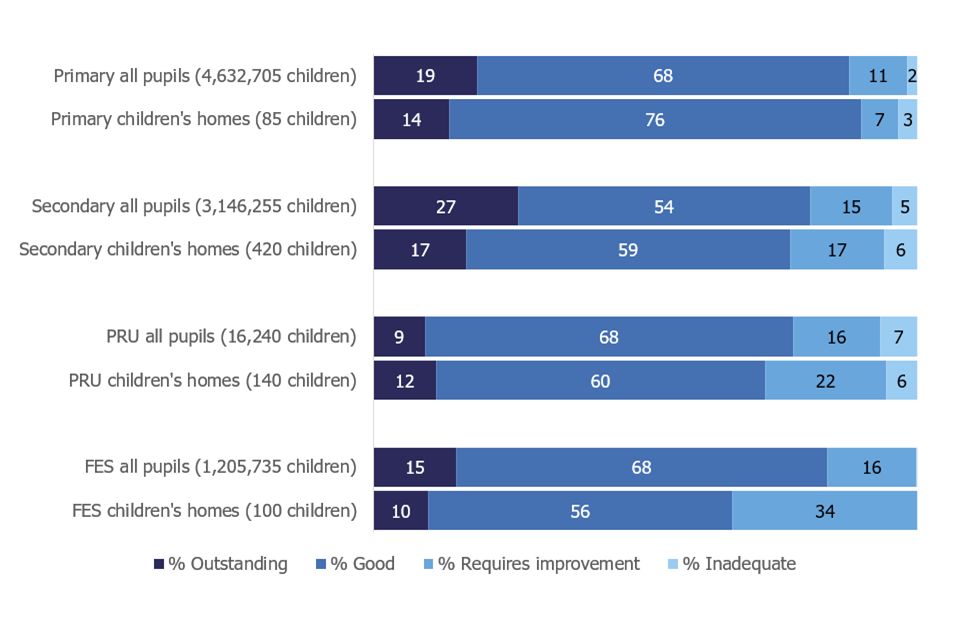
Numbers may not add up due to rounding. Numbers of children rounded to the nearest 5.
Download a zip file with the data used in figures.
State-funded mainstream education and academisation
The proportion of children in children’s homes who attended good or outstanding mainstream LA-maintained education providers was 77%. This was 10 percentage points lower than among all children in mainstream LA-maintained provision nationally.
The proportion who attended good or outstanding mainstream academies was 75%, 7 percentage points lower than among all children in academies nationally. Most of the difference was accounted for by those children who attended sponsor-led academies. The proportion of children in children’s homes in good or outstanding mainstream converter academies was similar to the proportion of all children nationally.
Figure 16: Proportion of children attending Ofsted-inspected mainstream state-funded provision by academisation status and overall effectiveness judgement as at 31 March 2019
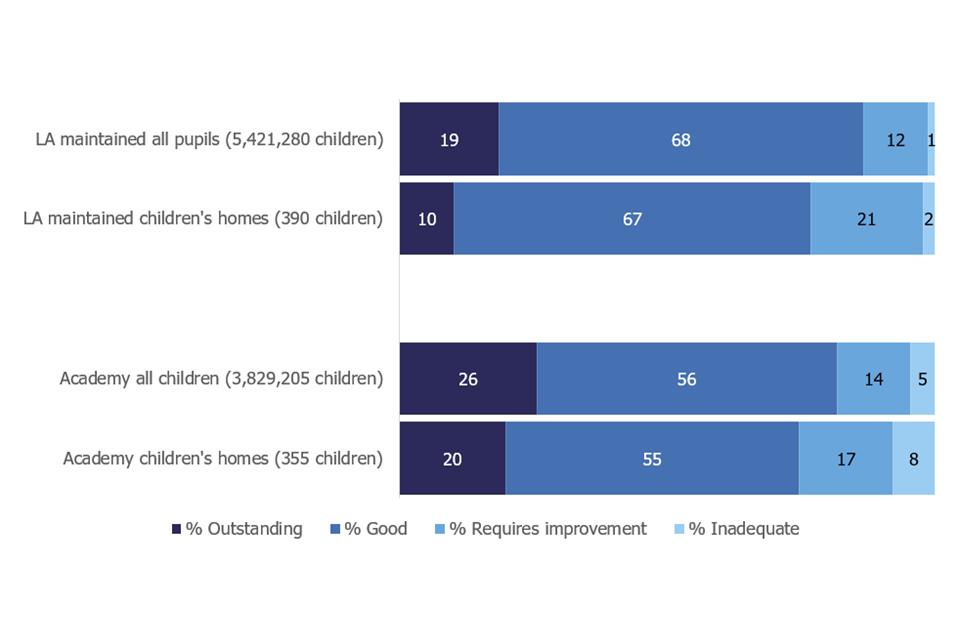
Download a zip file with the data used in figures.
Studies have shown for some time that although educational attainment gaps exist between children in care and their peers, these gaps are greatest for children who are in children’s homes. The goal of the LA is to find an educational setting that is best suited to the child’s needs and, wherever possible, ones that are judged good or outstanding. It is striking that, aside from 2 small groups of children (those in independent mainstream and primary schools), in most types of education, the LA had not achieved this. In fact, there were negative percentage gaps between children in our sample and their peers (Tables 3 and 4).
Table 3: Summary of the proportion of children in children’s homes, and nationally, attending good or outstanding educational provision
| Type of educational provision | Number of children in children’s homes | % of children in children’s homes in good and outstanding provision | % of all pupils in good and outstanding provision |
|---|---|---|---|
| All | 2,065 | 82 | 84 |
| Independent special | 730 | 84 | 87 |
| State-funded special | 480 | 88 | 93 |
| Independent mainstream | 105 | 80 | 79 |
| State-funded mainstream | 745 | 76 | 84 |
Table 4: Summary of the proportion of children in children’s homes, and all children nationally, attending good or outstanding state-funded, mainstream educational provision
| Type of educational provision | Number of children in children’s homes | % of children in children’s homes in good and outstanding provision | % of all pupils in good and outstanding provision |
|---|---|---|---|
| All state-funded mainstream | 745 | 76 | 84 |
| Primary | 85 | 90 | 87 |
| Secondary | 420 | 77 | 80 |
| PRU | 140 | 72 | 77 |
| FES | 100 | 66 | 83 |
| All state-funded mainstream | 745 | 76 | 84 |
| LA-maintained | 390 | 77 | 87 |
| Academy | 355 | 75 | 82 |
Summary of findings and future work
This study starts to address the shortfall in research identifying where children living in children’s homes are educated.
By using data collected in the children’s home Annex A, we can identify the educational provision of children who do not appear in the DfE’s school or alternative provision censuses. This is particularly important given the large proportions of independently educated children in the children’s home sector, and the smaller group attending FES providers, for which there is currently no collection that identifies the education of these vulnerable children.
Our sample, though, only covered around half of all children living in children’s homes at any one time. It included data from around 44% of all children’s homes active in 2018 to 2019.
Previous studies have found that the educational outcomes for children living in children’s homes are poor compared with their peers. To unpick this further, it is important to have a picture of where children living in children’s homes are educated. This forms the first step in our broader aim to map the journeys of children looked after, and children in need, through the social care system.
By identifying the provision accessed by children in children’s homes, this study also allows insight into the quality of education received by these children. This is achieved by examining the Ofsted judgements awarded to education providers. This highlights the extent to which the ‘School admission code’ has been successful in ensuring that all children looked after are in good or outstanding educational provision.
How do these findings compare with previous studies?
Table 4 shows that the types of education provision attended by our sample differs from the small sample of 56 children included in the 2012 study by Berridge, Biehal and Henry.[footnote 6]
The biggest disparity between the 2 groups was among the proportion attending special education providers. This was 28 percentage points higher for our sample. This difference may be partly accounted for by the ambiguous ‘provision within the residential home’ category used in the 2012 study by Berridge, Biehal and Henry.[footnote 7] Our sample was skewed in favour of private children’s homes. This may also have contributed to the higher proportion of children attending special education, as independent children’s homes are more likely to cater for children with complex physical and learning disabilities. Even after accounting for these differences in the underlying sample, the results of this study, with a much larger sample, suggest that a higher proportion of children living in children’s homes are in special education than has been reported to date.
Table 5: Proportion of children in Berridge, Biehal and Henry 2012 sample and Ofsted sample by educational provider type
| Education provision | Number of children (Berridge, Biehal and Henry 2012 sample) | Percentage (Berridge, Biehal and Henry 2012 sample) | Number of children (Ofsted sample) | Percentage (Ofsted sample) | Difference between Ofsted and Berridge, Biehal and Henry 2012 samples |
|---|---|---|---|---|---|
| Mainstream education | 20 | 36 | 615 | 24 | -12 |
| Further education college | 3 | 5 | 215 | 8 | +3 |
| PRU | 5 | 9 | 140 | 5 | -4 |
| Special school (day pupil) | 11 | 20 | 1,245 | 48 | +28 |
| Home/group tuition | 7 | 13 | 220 | 8 | -5 |
| Provision within the residential home | 4 | 7 | - | - | -7 |
| No current provision | 5 | 9 | 145 | 6 | -3 |
| Total | 56 | 100 | 2,570 | 100 | - |
Mainstream education includes both state-funded and independent mainstream schools, excluding PRUs. Home/group tuition includes virtual schools and alternative provisions. We excluded from our sample residential special schools and secure children’s homes. Other on-site and linked providers are listed under special school (day pupil) or mainstream education as appropriate. Within our sample, the total number of children excludes the children whose provision was unknown, those educated in Wales and those in employment/training.
Future work
This study is an initial attempt to contribute to the understanding of the experiences of children living in children’s homes by identifying where they are educated and, where available, what the Ofsted judgement of the educational provision was as at 31 March 2019.
In future work, we will focus on:
- using the techniques developed in this work to increase the sample size further to include most of the approximately 1,850 children’s homes providing short- and long-term care
- comparing 2018 to 2019 data with data from the most recent, 2019 to 2020, inspection year
- analysis of the number of hours of education provided to each child, currently recorded in Annex A
- using research that we are currently carrying out on the services provided by each children’s home
- triangulating Ofsted’s data with the DfE’s children looked after data return (also known as SSDA 903) to analyse characteristics, such as age, gender and ethnicity, and children’s journeys through the social care system
- the education of children in independent and semi-independent living settings
- collaborating with the DfE to determine the life-long outcomes for children living in children’s homes
Appendix: Methodology and limitations
Description of data sources
At the time of inspection, all children’s homes are required to complete an Annex A document. This study was based on responses to section 8, ‘Information about education provision for children currently living in the home’ for inspections completed in the 1 April 2018 to 31 March 2019 inspection year (see Figure A.1 below).
The Annex A responses were triangulated with provider information from the DfE’s Get information about schools (GIAS) data; inspection outcomes available from Ofsted’s reports website and inspection outcomes available from the ISI. Table A.1 below summarises the fields collected from each data source.
Table A.1: List of variables collected for each child
| Variable | Data type | Source |
|---|---|---|
| Inspection number | for example, 123456 | Ofsted Annex A |
| Inspection start date | for example, 01/05/2018 | Ofsted Annex A |
| Children’s home Ofsted unique reference number (URN) | for example, SC12345 | Ofsted Annex A |
| Children’s home setting name | for example, ‘Little Oaks’ | Ofsted Annex A |
| Children’s home setting postcode | for example, AA1 1AA | Ofsted registration data |
| Children’s home LA | for example, ‘Barnet’ | Ofsted Annex A |
| Child’s initials | for example, ‘AA’ | Ofsted Annex A |
| Name of placing LA | such as the home location of the child before becoming looked after, for example ‘Enfield’ | Ofsted Annex A |
| Name of main education provider (Annex A) | for example, ‘St Thomas’ | Ofsted Annex A |
| Name of main education provider | for example, ‘St Thomas’ Academy’ | GIAS |
| DfE URN of main education provider | for example, 12345 | GIAS |
| Postcode of main education provider | for example, BB1 1BB | GIAS |
| Provider type of main education provider | for example, mainstream school | GIAS |
| Phase of main education provider | for example, secondary | GIAS |
| Overall effectiveness of main education provider at time of children’s home inspection | for example, 2 – good | Ofsted inspection website |
Data extraction and matching
We used R (a statistical programming language) to extract the educational information from Excel and Word Annex A documents completed by children’s homes and uploaded to an Ofsted database. This meant we could analyse data about 2,600 children living in children’s homes that were inspected in the 2018 to 2019 inspection year.
We linked this data to the inspection judgements of the education providers that these children attended to get a better picture of the quality of education they were receiving.
The steps involved in this process are:
1. Extracting text from Excel and Word documents
The first step was to extract the children’s educational placement data. We wrote R scripts to read and extract the educational information recorded in the Annex A documents.
2. Match most likely education provider, as listed on Ofsted’s reports website
We wrote an R script to match the free-text field for the name of the education provider on the Annex A documents with the reports listed on Ofsted’s reports site. This used the free-text field and the postcode of the children’s home to pull back the most likely education provider for each pupil in our sample.
3. Clean and quality assure data
When we inspected the results, around half the education URNs seemed correct when compared to the original free-text field entry. The main sources of mismatches were:
- the education provider specified was not DfE-registered and so did not appear on the websites we used
- the education provider was outside the 10-mile radius of the children’s home we initially required in our search query
- there was no education provider (the child was not in education, employment or training)
- the provider name was misspelled, leading to poor-quality search results
We dealt with some of these by relaxing our distance requirements and some manual fixes. We also had a list of non-DfE-registered providers (often ‘alternative providers’) and a list of DfE-registered providers that are not inspected by Ofsted (such as independent schools inspected by other inspectorates).
4. Join with other data sets
Once we had established the Ofsted URN of each children’s home and the DfE URN of each education provider, we were able to join our sample to other datasets including Ofsted inspection outcomes, the National Pupil Database, the ‘Children looked after 903 dataset’ and Ofsted registration information.
How representative was our sample?
The final sample consisted of 2,600 children living in 815 children’s homes. This represents around 44% of all homes and just under half of all children living in children’s homes at any one time in the 2018 to 2019 inspection year.
We only included Annex As completed in Word or Excel in the sample, as it was easier to automatically extract data from these formats using the programming language R. This may have introduced a bias into the sample, since no handwritten and scanned Annex A returns were included. Some Annex A entries were ambiguous or included errors. The Annex A only asks for the name of the educational provision, not the URN or postcode. We developed a tool in R to match these entries to the most likely provider, but this may not have been 100% accurate.
Children’s homes Annex A documents collect information about the name of educational provision attended by young people resident in a children’s home at the time of inspection. Annex A documents do not collect the URNs or postcodes of educational provision, nor the age, gender or any other demographic information about the young people resident in the home at the time of inspection. The unique pupil number (UPN) of young people is also not provided. We were therefore not able to reliably link the young people in Annex A documents to the National Pupil Database and ‘Children looked after’ censuses. Annex A documents also do not collect the period of time the young person has been resident in the home. We were therefore unable to establish whether young people not currently in education, employment or training (NEET) were persistently NEET, or had only just moved to a new location and would be moving into education/employment imminently.
Ofsted relies on providers to update information regarding which corporate entities own children’s homes and independent educational providers. We do not always receive this data promptly. We cleaned the data to reduce the effect of these data issues, but acknowledge that some errors may remain in the final sample.
Regional coverage
We examined how representative our sample was in terms of the region the homes were located in and the sector (LA, private or voluntary) of the children’s homes. Table A.2 and Figure A.1 show that the sample was broadly representative of the proportion of children’s homes nationally.
Table A.2: Number and proportion of children’s homes by region as at 31 March 2019 compared with our sample
| Region | Number of children’s homes nationally | Proportion of children’s homes nationally | Number of children’s homes in sample | Proportion of children’s homes in sample | Difference between sample and national |
|---|---|---|---|---|---|
| East of England (EoE) | 129 | 7% | 73 | 9% | +2%pt |
| North West (NW) | 472 | 26% | 192 | 24% | -1%pt |
| South West (SW) | 127 | 7% | 80 | 10% | +2%pt |
| West Midlands (WM) | 331 | 18% | 179 | 22% | +4%pt |
| London (Lon.) | 85 | 5% | 25 | 3% | -2%pt |
| North East, Yorkshire and The Humber (NEYH) | 282 | 15% | 93 | 11% | -3%pt |
| East Midlands | 189 | 10% | 74 | 9% | -1%pt |
| South East (SE) | 229 | 12% | 99 | 12% | 0%pt |
| Total | 1,844 | 100% | 815 | 100% | - |
Excludes children’s homes only offering short breaks, secure children’s homes and children’s homes registered as residential special schools.
Figure A.1: Regional representativeness of children’s home sample relative to the distribution of children’s homes nationally
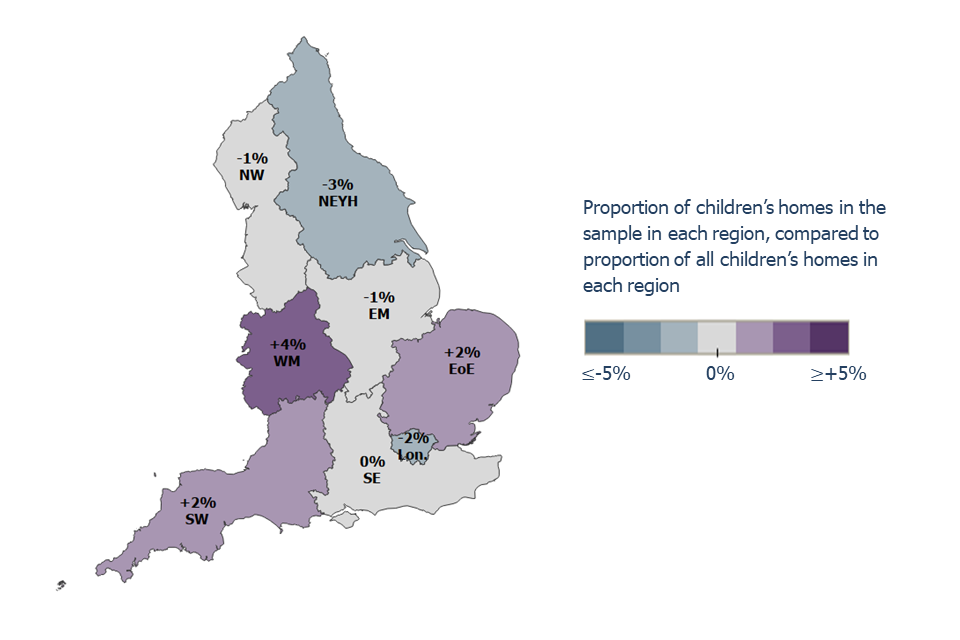
A χ2 test of independence, however, showed that our sample was significantly different (at the 1% significance level) from the national picture in terms of the distribution of homes by region, χ2 (36.6, N=8, df=7, p<.01).
Examining how the imbalances in each region contributed to this difference showed that the differences were statistically significant at the 1% level in 3 regions. The West Midlands and South West were over-represented, while the North East, Yorkshire and Humber was under-represented in the sample.
Table A.3: Regional representativeness of sample compared with all children’s homes nationally: χ2 test of independence with standardised adjusted residuals
| Region | Standardised adjusted residuals |
|---|---|
| East of England (EoE) | +2.19 |
| North West (NW) | -1.33 |
| South West (SW) | +3.30 |
| West Midlands (WM) | +2.99 |
| London (Lon.) | -2.10 |
| North East, Yorkshire and Humber (NEYH) | -3.08 |
| East Midlands (EM) | -1.10 |
| South East (SE) | -0.23 |
Absolute standardised adjusted residuals > 2.58 are considered significant at 1% significance level.
χ2 (36.6, N=8, df=7, p<.01)
Looking at the Ofsted judgement profiles of state-funded schools in each region shows that educational providers in the South West and West Midlands regions were generally more likely to receive an inadequate judgement than elsewhere. As a result, the proportion of children attending inadequate educational provision in our sample may have been higher than we would expect among all children in children’s homes nationally.
Sectoral coverage (LA, private and voluntary children’s homes)
Table A.4 shows that the split of children’s homes by sector was very similar in the sample as among all children’s homes nationally. The difference was not significant at the 1% level χ2 (0.20, N=3, df=2).
Table A.4: Number and proportion of children’s homes by sector as at 31 March 2019
| Sector | Number of children’s homes nationally | Proportion of children’s homes nationally | Number of children’s homes in sample | Proportion of children’s homes in sample | Difference between sample and national |
|---|---|---|---|---|---|
| LA | 264 | 14% | 121 | 15% | +1%pt |
| Private | 1,483 | 80% | 652 | 80% | 0%pt |
| Voluntary | 97 | 5% | 42 | 5% | 0%pt |
| Total | 1,844 | 100% | 815 | 100% | - |
Excludes children’s homes only offering short breaks, secure children’s homes and children’s homes registered as residential special schools.
-
Unpublished data from the SSDA 903 2018-2019, Department for Education, December 2019. ↩
-
A O’Sullivan and R Westerman, ‘Closing the gap: investigating the barriers to educational achievement for looked after children’, in ‘Adoption and Fostering’, Volume 31, Issue 1, 2007, pages 13–20 (viewed on 25 January 2021); D Berridge, ‘Educating young people in care: what have we learned?’, in ‘Youth Services Review’, Volume 34, Issue 6, 2012, pages 1171–1175 (viewed on 25 January 2021); K Liabo, K Gray and D Mulcahy, ‘A systematic review of interventions to support looked-after children in school’, in ‘Child and Family Social Work’, Volume 18, Issue 3, 2012, pages 341–353 (viewed on 25 January 2021). ↩
-
J Sebba, S Strand, D Berridge and S Thomas, ‘The Educational Progress of Looked After Children in England: Linking Care and Educational Data’, Nuffield Foundation, 2015 (viewed on 25 January 2021). ↩
-
D Berridge, N Biehal and L Henry, ‘Living in children’s residential homes’, Department for Education, March 2012 (viewed on 25 January 2021). ↩
-
‘State funded schools inspections and outcomes as at 31 March 2019’, Ofsted, June 2019 (viewed on 25 January 2021). ↩
-
D Berridge, N Biehal and L Henry, ‘Living in children’s residential homes’, Department for Education, March 2012 (viewed on 25 January 2021). ↩
-
D Berridge, N Biehal and L Henry, ‘Living in children’s residential homes’, Department for Education, March 2012 (viewed on 25 January 2021). ↩

